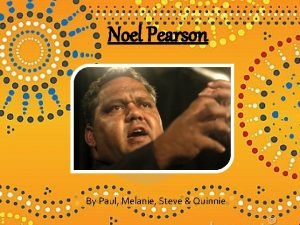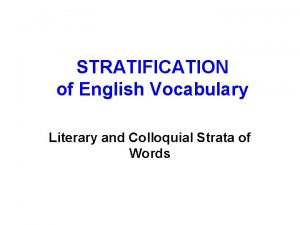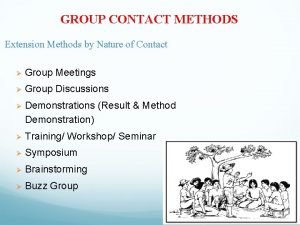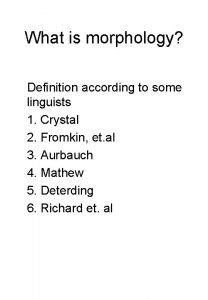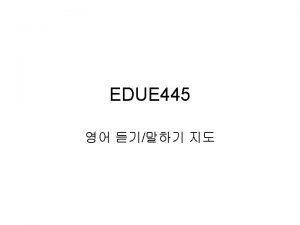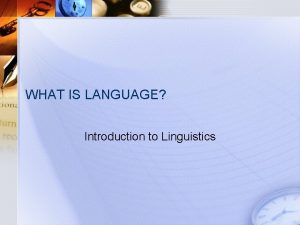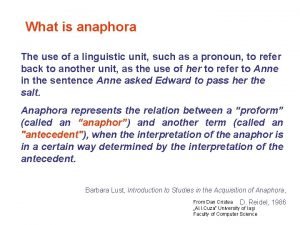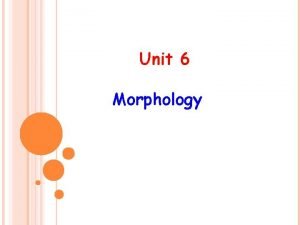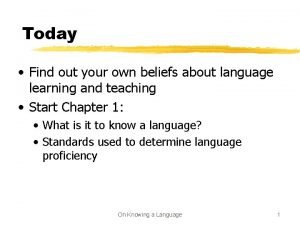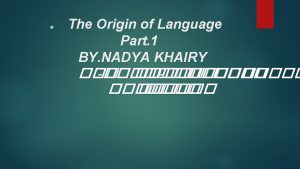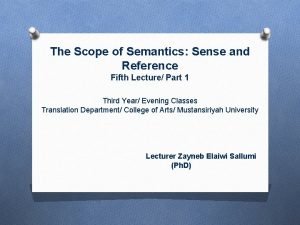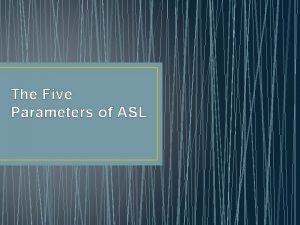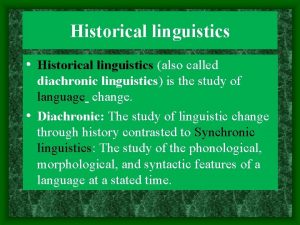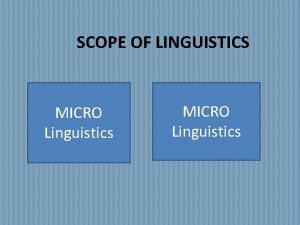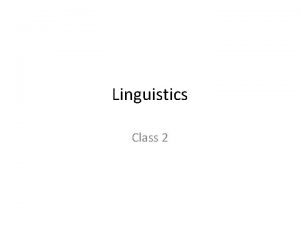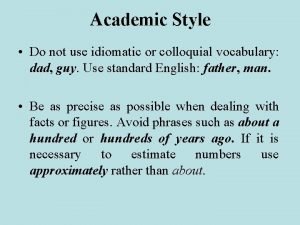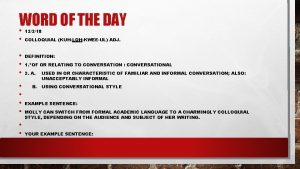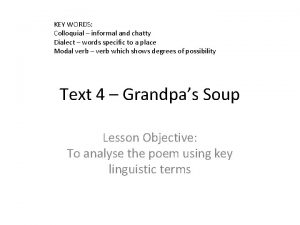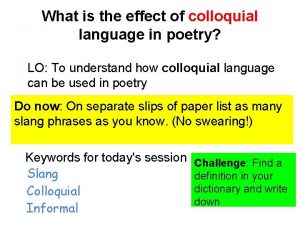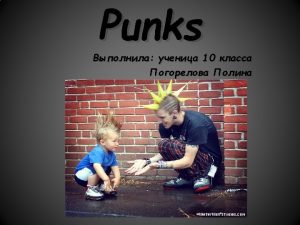COLLOQUIAL LINGUISTICS CONTACT LINGUISTICS Group 9 1 CONTACT


















































- Slides: 50

COLLOQUIAL LINGUISTICS & CONTACT LINGUISTICS Group 9

1. CONTACT LINGUISTICS AND SINGAPORE ENGLISH PART 1

Pidgin • a simplified language that develops between two or more groups that do not have a language in common • not all simplified or "broken" forms of a language are pidgins each pidgin has its own norms of usage

Pidgin • may be built from words, sounds, or body language from multiple other languages and cultures • not the native language of any speech community, but is instead learned as a second language.

Examples of Pidgin Nigerian Pidgin Chinese Pidgin English in China Hawaiian Pidgin

Hawaiian Pidgin Creole language based in part on English used by many residents of Hawaii Example: "Inside dirt and cover and blanket, finish" "They put the body in the ground and covered it with a blanket and that's all. "

Creole • Stable natural language developed from a pidgin • Navitised by children as their primary language • Vocabulary is largely supplied by the parent languages (lexifier) though there are often clear phonetic and semantic shifts • Has own unique grammatical rules that may differ from those of the parent language

Pidgin to Creole – Hawaiian Pidgin Form of communication between natives and immigrants/plantati on workers 19 th century, Hawaiian school children learned Hawaiian pidgin from some of their classmates CREOLE PIDGIN Acquired words from other languages such as Portugese, Hawaiian and Cantonese Became first language of Hawaii

Hawaiian Creole • Does not just include words from English (parent language) Source Word Meaning Hawaiian pau lanai puka akamai okole pilau 'finished' 'verandah' 'hole' 'clever' 'buttocks' 'filthy' Japanese obake shi-shi 'ghost' 'urinate' Portuguese malasada 'doughnut without a hole

Differences Pidgin Have no native speakers Creole Have native speakers Results of extended contact Develop from pidgins, learnt as a between groups with no language first language by a large number in common, they are used mostly of speakers for trade Simple grammatical structures More complex in structure, wider range of vocabulary to express a wide range of meanings Not used for group identification May take on national and official functions

1. CONTACT LINGUISTICS AND SINGAPORE ENGLISH PART 2

SE a Creoloid? • Shares many similarities with creoles but is not one • New concept established to accommodate its peculiarities Peculiarities • Did not develop from a pidgin • Existence traced to transference of certain features from languages of local ethnic groups to English acquired in schools

SE a Creoloid? Peculiarities • One of the several ‘native’ languages • Used as lingua franca in inter-ethnic group communication

SE a Creoloid? Peculiarities • Resembles post-creole • Converges towards English- the language it is derived from

Linguistic Ecology • Social factors in the linguistic environment of speakers CSE Carribean/African pidgins/creoles -Did not originate from pidgin English, but standard English -Common history of slavery -Result of standard English taught before WWII and bilingual education after WWII -Impact of multilingualism: Borrowing of lexical items/intonation from other languages -African slaves who spoke different African languages had to communicate with one another and with the Europeans

Linguistic Ecology Example: Haitian Creole • Pidgin first developed for communication between African slaves and their French colonial masters • Acquired vocabulary from French & grammar from various African languages • From pidgin to creole: offsprings of the Africans expanded on the pidgin and became native speakers

2. NP ELLIPSIS AND SUBSTRATIST EXPLANATION

Subtratist Explanation • Differences between Colloquial Singapore English (CSE) and Standard English in terms at all levels of grammar and usage • Differences due to linguistic influences from the indigenous languages spoken in Singapore, such as Chinese and Malay

Noun Phrase Ellipsis • The deletion of Noun Phrases in sentences • CSE makes extensive use of noun phrase ellipsis in all syntactic positions, such as subjects, objects and possessors

Noun Phrase Ellipsis If the context is unambiguous, there is no need to mention the subject at all. Subject Omission (a) After Ø get some sickness, Ø can’t help it ‘After one gets sick, one cannot help it. ’

Noun Phrase Ellipsis If the context is unambiguous, there is no need to mention the object at all. Object Omission (b) I never try Ø before lah. ‘I have never tried it before. ’

Noun Phrase Ellipsis If the context is unambiguous, there is no need to mention the possessor at all. Possessor Omission (c) Ø Head very pain. ‘My head is painful. ’

Noun Phrase Ellipsis Once the subject is established, e. g. through the use of a personal pronoun, it is unnecessary to repeat it later in discourse Example: I like to draw, but Ø cannot do well lah. I like to draw, but I cannot do it well.

Noun Phrase Ellipsis Does it come from Chinese Varieties: Hokkien, Cantonese, Mandarin? Does it come from Malay Varieties: Baba Malay and Bazaar Malay? Or does it come from both Chinese and Malay?

Chinese Varieties Common in Chinese Varieties If the context is unambiguous, there is no need to mention the subject at all. Subject Omission (a) (wo) sheng bing le, (wo) jiu mei you ban fa After (I) get sick, (I) can’t help it

Chinese Varieties Common in Chinese Varieties If the context is unambiguous, there is no need to mention the object at all. Object Omission (b) Wo mei you shi guo (zhe ge) lah ‘I have never tried (it) before. ’

Chinese Varieties Common in Chinese Varieties If the context is unambiguous, there is no need to mention the possessor at all. Possessor Omission (c) (wo de) Tou hen tong. ‘(My) head is painful. ’

Chinese Varieties Once the subject is established, e. g. through the use of a personal pronoun, it is unnecessary to repeat it later in discourse Chinese Ni xi huan zuo shen me? You like do what? What do you like to do? Xi huan kan dian ying. Like watch movie. (I) like to watch movie.

Chinese Varieties Once the subject is established, e. g. through the use of a personal pronoun, it is unnecessary to repeat it later in discourse Hokkien Dai bak cia tau an zua Tai pei train station how How do I get to Taipei train station? Ze gong cia e sai. Sit public bus can (You) can take the public bus. ki? go?

Chinese Varieties Topic Prominence Sentence structure is determined by the topic, may be independent of the syntactic ordering of subject, verb and object. Xia yu le (It is) Raining already. Hen chao ah! (It is) Very noisy!

Malay Varieties Common in Malay Varieties If the context is unambiguous, there is no need to mention the subject at all. Ingat-ingat, waktu masih kecil, sering pergi memancing Remember when still small, often go fishing I remember when I was still small, I often went fishing.

Evaluation • By-product of both Chinese and Malay varieties • Substrates of Singapore English: share the same grammatical features • Topic Prominence • Optional Syntactic Agreement • Copula Deletion • Noun-phrase Ellipsis All related and play a part in contributing to the feasibility of noun-phrase ellipsis in Singapore English.

3. PRAGMATICS OF SENTENCE-FINAL PARTICLES

Discourse Particles • No direct semantic meaning but serves a pragmatic function • Changes tone of the sentence but not its grammatical & propositional meaning • Indicate speaker’s attitude • Feature of spoken language • Informal if included in written language

Some Examples of Discourse Particles English Particle When Used in a Sentence Well “Well, I agree with you that the Earth is round. ” You Know “This question is not as easy as it seems, you know. ” Like “This is, like, the most delicious cupcake I have ever eaten!” So. Well. You know. Like. Now. You see. Oh. I mean. Ok. Actually.

Some Discourse Particles in Singlish Particle When Used in a Sentence Lah “There’s something for everyone, lah. ” What “No one parks here, what” Hor “This shopping center very nice hor. ” Meh “You don’t like that one, meh? ”

2 a. Lah “There’s something here for everyone, lah. ” Without “Lah” With “Lah” There is enough things here to go around, everyone will receive something. Don’t worry, there is enough things here to go around, everyone will receive something. Sounds Reassuring Can you stop questioning me, there is definitely enough things here to go around, everyone will receive something. Shows Impatience Pragmatic Function: Conveys the mood and attitude of the speaker

2 a. Lah Different mood & attitude conveyed with different ways of saying “Lah”: Stressed (Dragged) “Lah” Unstressed (Short) “Lah” • Friendly • Reassuring • Used with pleas and suggestions – appeal for accomodation • Hostile • Impatient • Used with request or command “Go to Chinatown lah. ” “Give me more time lah. ” “Please lah” “Finish your food lah!” “Stop it lah!” “Please lah!”

2 b. What “No one parks here, what. ” Without “What” With “What” Nobody parks their vehicles at this Haven’t I told you before already, spot/ this spot is empty. nobody parks their vehicles at this spot/ Didn’t I tell you this spot will be empty? And it is! Mark Obviousness You told me that this parking spot will be filled but apparently this spot is empty. Mark Contradiction Pragmatic Function: Marks contradiction or mark obviousness

2 b. What Other Pragmatic Functions: Pragmatic Functions Use in Sentences • Indicating an objection • Providing an explanation -Why didn’t you come inside? -You told me to stay outside, what! • Offering a suggestion -How ah, I have no money for lunch! -You can go withdraw, what.

2 c. Hor “This shopping centre very nice hor. ” Without “Hor” With “Hor” This shopping centre is very nice to shop in/ looks very nice. Doesn’t this shopping centre look very nice? / Isn’t it nice to shop in this shopping centre? Pragmatic Function: Attempt to garner support for a proposition In this case, proposition: the shopping centre has an attractive physical appearance or offers a pleasurable shopping experience

2 c. Hor Other Pragmatic Functions: Pragmatic Functions Use in Sentences • Warning You better be careful, hor! • Reminder Our english report is due on Wednesday, hor!

2 d. Meh “You don’t like that one, meh? ” Without “Meh” With “Meh” Are you saying that you do not like that Are you sure you do not like that one? I thought you did! Indicate Surprise Are you sure you do not like that one? Do not lie to me/ Don’t act Indicate Skepticism Pragmatic Function: Indicate surprise or skepticism

4. OWNSELF IN CE = 自 己’ZIJI’ IN CHINESE?

Data Given (1) a. Ownself open the door! b. You ownself open the door! (CSE: Wee 2007: 366) (2) (Ni) ziji chi fan! 2 singular self eat rice ‘(You) eat rice by yourself!’ (Mandarin: Wee 2007: 371) (3) a. * He cut ownself. b. * He give ownself a lot of problems. (CSE: Wee 2007: 365) (4) Lisi zai zebei (ta) ziji. Lisi duration blame 3 singular self ‘Lisi is blaming himself. ’ (Mandarin: Wee 2007: 371)

Analysis of Data (1) Language Sentence Given: Singlish a. Ownself open the door! Ad. V V O a. You ownself open the door! S Ad. V V O (Ni) ziji kai men! N Ad. V V N Chinese

Analysis of Data (2) Language Sentence Given: Chinese S Ni 2 singular Singlish S You Ad. V V ziji chi self eat N fan rice Ad. V V ownself eat N rice Observations: • ‘Ownself’ is used as an adverb • When ‘ziji’ is used as an adverb, we can replace it with ‘ownself’

Comparing Data (3) and (4) Data No. Sentence *(3 a) S V O He cut ownself. Ta Ge Shang Ziji *(3 b) S V O He give ownself a lot of Ta Gei Ziji hen duo (4) N Aux V O Lisi zai zebei (ta) ziji Lisi duration blame 3 singular self ‘Lisi is blaming himself. ’ N problems wen ti Observations: • ‘Ownself’ is used as an object • When ‘ziji’ is used as an object, we cannot replace it with ‘ownself’

Did ‘Ownself’ develop from ‘Ziji’ in Chinese? Evidence in Favour Evidence Against • ‘ziji’, when substituted with ‘ownself’, fits better into the meaning of the sentence than when ‘X-self’ is substituted with ‘ownself’ • In English, ‘X-self’ also has an adverb and noun form • ‘Ownself’ can also possibly develop from ‘X-self’ in English a. I opened the door ‘myself’. (adverb) b. I cut ‘myself’. (noun) ‘X-self’ used as an adverb I opened the door by myself. I opened the door by ownself. ‘Ziji’ used as an adverb Wo ziji kai men. I ownself opened the door. X

THANK YOU!
 Language
Language Linguistics vs applied linguistics
Linguistics vs applied linguistics Colloquial language
Colloquial language Special colloquial vocabulary
Special colloquial vocabulary Colloquial aphesis
Colloquial aphesis Colloquial vs formal
Colloquial vs formal Colloquial vs formal
Colloquial vs formal Colloquial language
Colloquial language Colloquial language
Colloquial language Colloquial meaning
Colloquial meaning Jargonisms
Jargonisms Which force
Which force Sliding contact bearing and rolling contact bearing
Sliding contact bearing and rolling contact bearing What is non contact force
What is non contact force Is tension force contact or noncontact
Is tension force contact or noncontact Irritant vs contact dermatitis
Irritant vs contact dermatitis Is air resistance a contact or noncontact force
Is air resistance a contact or noncontact force Schottky contact vs ohmic contact
Schottky contact vs ohmic contact Post encounter stage
Post encounter stage Contact and non contact forces
Contact and non contact forces Contact and non contact forces
Contact and non contact forces Describe group contact method
Describe group contact method Group polarization.
Group polarization. Within group variance vs between group
Within group variance vs between group Anova within group and between group
Anova within group and between group Types of social group
Types of social group Group 1 and group 2 specialties
Group 1 and group 2 specialties Thermal stability of group 2 carbonates and nitrates
Thermal stability of group 2 carbonates and nitrates Amino group and carboxyl group
Amino group and carboxyl group Amino group and carboxyl group
Amino group and carboxyl group In group out group
In group out group Group yourself or group yourselves
Group yourself or group yourselves Sumner's classification of social groups
Sumner's classification of social groups Joining together group theory and group skills
Joining together group theory and group skills What is inflectional and derivational morphology
What is inflectional and derivational morphology Linguistics
Linguistics Dialectology in linguistics
Dialectology in linguistics Double articulation
Double articulation Competence vs performance in linguistics
Competence vs performance in linguistics Catafora
Catafora Utterance linguistics
Utterance linguistics Morpology
Morpology Back-formation words
Back-formation words Strength and weakness of traditional grammar
Strength and weakness of traditional grammar Competence vs performance in linguistics
Competence vs performance in linguistics Imitation theory of language acquisition example
Imitation theory of language acquisition example Human language is a result of divine gift
Human language is a result of divine gift What is sense in semantics
What is sense in semantics Why are the 5 parameters of asl important
Why are the 5 parameters of asl important Pragmatics in discourse analysis
Pragmatics in discourse analysis Styles in linguistics
Styles in linguistics







